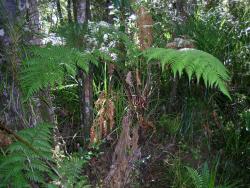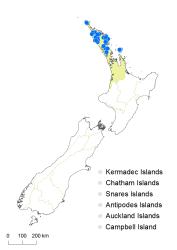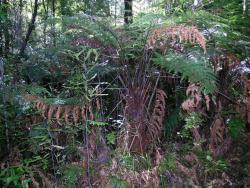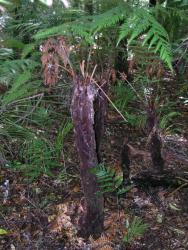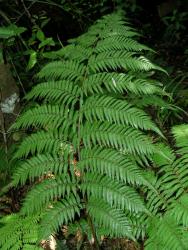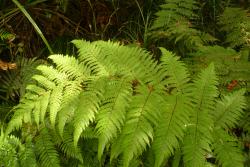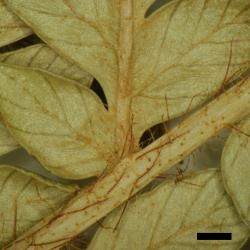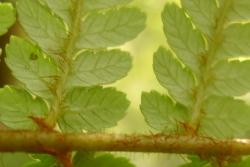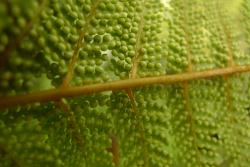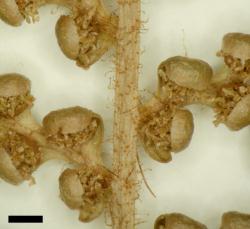- ≡ Dicksonia lanata var. hispida Colenso in Hooker, Sp. Fil. 1, 69 (1844)
Rhizomes occasionally creeping, but usually erect, forming a short woody trunk 0.2–2 m tall, up to 150 mm diam., covered in brown adventitious roots and brown stipe bases; lacking buds, bearing red-brown multicellular hairs near the apex. Fronds 500–2000 mm long, held erect, falling when old; the fertile pinnae often markedly reduced compared with the sterile; dead fronds orange-brown. Stipes 210–1170 mm long, red-brown at very base, becoming chestnut-brown, yellow-brown or green distally, or occasionally green throughout, smooth, sometimes bearing fine golden-brown hairs at the junction with the rhizome, densely covered in red-brown multicellular hairs up to 25 mm long proximally, and pale brown or red-brown hairs to c. 3 mm long distally. Laminae 2-pinnate-pinnatisect to 3-pinnate (sterile pinnae) or deeply 3-pinnate-pinnatifid (fertile pinnae), ovate or triangular, 420–1130 mm long, 200–700 mm wide, darker green on adaxial surfaces, coriaceous, smooth, the sterile segments usually flat or slightly involute; abundantly hairy on abaxial surfaces of rachis, pinna midribs and costae; hairs fine, multicellular, colourless or pale brown, up to 1 mm long, straight or slightly curled, uniformly distributed, interspersed with red-brown, thicker, rigid hairs up to 2.5 mm long; rachis yellow-brown or green. Primary pinnae in 15–23 pairs, ovate or triangular; the longest below the middle, 125–425 mm long, 50–165 mm wide, stalked; the basal pair 100–340 mm long. Secondary pinnae narrowly ovate or narrowly triangular, the longest 25–85 mm long, 8–25 mm wide, stalked. Longest tertiary pinnae 4–14 mm long, 1.5–4 mm wide, stalked or sessile or adnate, divided more than halfway to midrib; ultimate segments slightly rounded, usually bearing a single sorus. Sori terminating veins at margins of lamina, ovate, 1–1.5 mm long, slightly elongated along the lamina margin.
Dicksonia lanata subsp. hispida is a short-trunked tree fern found most commonly as an understorey plant in kauri forest. It is distinguished from subsp. lanata by the presence of a trunk, and by the presence of rigid, multicellular, red-brown hairs among shorter, pale brown hairs on the abaxial surfaces of the costae and pinna midribs. It lacks the dense patches of long, woolly, curled hairs present in subsp. lanata, but the hairs are sometimes slightly clustered in sterile fronds.
In the absence of hairs, subsp. hispida can sometimes be distinguished by its darker green laminae; sterile lamina segments, which tend to be flat or slightly involute; fertile pinnae, which are sometimes markedly reduced compared with the sterile; somewhat longer and narrower tertiary pinnae; and only one sorus on the lowermost ultimate segments of the tertiary pinnae.
North Island: Northland, Auckland.
Altitudinal range: 10–550 m.
Dicksonia lanata subsp. hispida grows primarily in coastal and lowland forest, and locally in montane forest, from North Cape to the northern Kaipara Harbour and Great Barrier Island. It grows from near sea level, reaching 450 m on Great Barrier Island, and 550 m in the Tutamoe Ecological District.
Dicksonia lanata subsp. hispida occurs most frequently in lowland kauri, podocarp or taraire forest, but is also found in mature mānuka or kānuka scrub, and occasionally on gumland.
This taxon was first collected by Colenso from the Bay of Islands and a specimen (No. 351) sent to William Hooker at Kew in a letter dated 20 May 1844, together with a manuscript entitled Filices Novae in which it was described as a new variety (see St. George 2009). Colenso later published the variety as D. lanata var. hispida in the Tasmanian Journal of Natural Sciences (Colenso 1845). However, before then, Hooker cited Colenso's specimen and his full description in Species Filicum (Hooker 1844–1846). Hooker did not intend to pre-empt Colenso, expecting Colenso's description to have been published before his, but in the event, Species Filicum appeared in print first, and is the first validly published description for the variety. Because Hooker attributed the name and full description to Colenso, the variety must be cited as D. lanata var. hispida Colenso in Hooker (Art. 46.2 Note 1). The variety was raised to subspecific rank by Brownsey & Perrie (2014).



